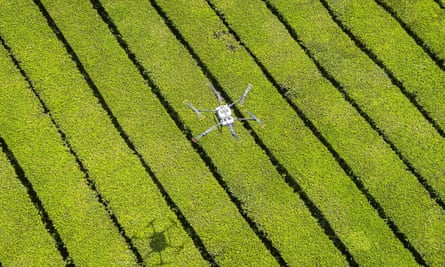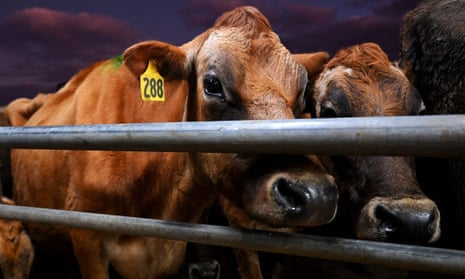In some ways, this year’s UN climate summit held in Egypt was all about food. In the context of crop failures and food insecurity, due to extreme weather and dwindling diversity, as well as rising food prices exacerbated by Russia’s war in Ukraine and the tight grip of corporate monopolies – Cop27 included the first ever day dedicated to food and climate.
Scientists are clear that the interconnected climate, environmental and food crises require bold transformative action to drastically reduce greenhouse gases and improve resilience. Food systems produce a third of human-caused greenhouse gas emissions. Cattle ranching is the main driver of Amazon rainforest loss, while industrialized food production is the biggest threat to 86% of the world’s species at risk of extinction.
But at Cop27, as in the debate more broadly, corporate interests dominated. Campaigners and NGOs say the food industry’s fingerprints were all over the solutions being touted, including an array of technologies and incentives that they say will do little to cut big food’s huge climate footprint, reduce diet-related diseases or increase food security and climate resilience in the long term.
“From treating cow burps to robotic weeders, none of the false solutions on offer at Cop27 come close to stopping the industrial food production from being an engine of planetary destruction,” said Raj Patel, food justice scholar and author of Stuffed and Starved. “Agribusiness and governments offered a series of patented patches designed not to transform the food system, but to keep it the same.”
There’s a lot still to unpick from Cop27, but here are some of the food “solutions” that experts told the Guardian they are most alarmed about:
1 The rise of ‘climate-smart agriculture’
The phrase “climate smart” – the mother of all buzzwords – has made its way into climate plans and policymaking, adopted by corporations, governments and multilateral agencies, such as the World Bank and FAO.
Billions of dollars are going into research on so-called climate-smart tech solutions such as robotics, AI, net zero dairy, cultivated meat and precision farming, including drones, GPS and drip-irrigation technologies. While proponents say these will increase productivity, help farmers adapt to the climate crisis, and cut emissions, critics say that the phrase “climate smart” has become an all-encompassing cover for rebranding harmful farm practices.
A key proponent of climate-smart agriculture is the Agriculture Innovation Mission for Climate initiative (Aim4C), a joint initiative spearheaded by the US and the UAE, which has promised $4bn in agricultural innovation to reduce emissions. It is supported by 40 countries and some of the world’s largest food companies including PepsiCo, the meat giant JBS and CropLife, an association of agrochemical companies. More than two-thirds of its partners are in the US or Europe, according to a DeSmog analysis, with not a single group representing Indigenous communities listed among its knowledge partners.
Aim4C has no clear plans to significantly slow or reduce activities such as industrial meat production and fertilizer use, which climate scientists say are fundamental to curbing global heating.
“AIM’s agritech solutions are not a strategy for 21st-century ecological change that benefits all of humanity and the web of life. Rather, this is more business as usual” said a spokesperson for the International Coalition on Climate and Agriculture, an alliance of activists and civil leaders.
2 Tech fixes for food’s giant methane problem
Methane is a short-lived but powerful heat-trapping gas that accounts for about a third of the rise in global temperature since the pre-industrial era. Livestock – through cattle burps, manure and the cultivation of feed crops – is responsible for nearly a third of global anthropogenic methane emissions, which is why scientists are clear that reducing meat and dairy consumption in the global north is essential to curbing global heating to 1.5C.
But the focus at Cop27 was not on changing human diets but rather cows’ diets – to make their burps less gassy.
There was much excitement from JBS, Nestlé, the world’s largest food and drinks company, and the meat and dairy trade groups about the boom in methane-reducing feed additives made from ingredients such as seaweed, ozone, enzyme inhibitors, green tea and garlic.
But the long-term risks and benefits of these emerging products remain unclear, and those currently on the market are only affordable to industrial cattle farmers and food companies that are invested in growing meat and dairy consumption, not reducing it.

“At best, these technologies provide a cover for the large meat and dairy corporations to continue overproducing on polluting factory farms,” said Amanda Starbuck, research director at Food and Water Watch.
3 Increasing access to fossil fuel-based fertilizers as the answer to food insecurity
The global food system is a heavy user of synthetic nitrogen fertilizers, produced in an energy-intensive process reliant on fossil fuels. They are credited with helping to increase yields and reduce hunger, but their expansion has come at a huge cost to the environment, climate and human and animal health.
Synthetic nitrogen fertilizers are responsible for 2% of global greenhouse gas emissions, according to a 2022 study, which found that reducing their use “offers large mitigation potential” in addition to other health, environmental and economic benefits.
Yet curtailing synthetic fertilizers was not on the agenda at Cop27, rather the focus of industry reps and European and US officials was on fertilizer access and “efficiency” – helping farmers use increasingly costly nitrogen inputs in smarter ways.
The US, EU, Norway, Germany and the Netherlands announced $109m of public funds (plus $26m in private investment) to expand fertilizer access and efficiency to combat food insecurity.

But according to the UN special rapporteur on the right to food, Michael Fakhri: “Chemical fertilizers do not ensure food security. Their pervasive use sometimes increases crop production in the short term, but it creates a longer-term dependency on corporations and trade … the ultimate goal must be to wean them off this dependency as soon as possible.”
Branding fertilizer efficiency as climate action is further evidence of the industry controlling the narrative, said Lili Fuhr, deputy director for climate and energy at the Centre for Environmental Integrity. “Synthetic fertilizers are just fossil fuels in another form. Fertilizer companies know they will soon be under scrutiny and are trying to divert attention from production to more efficient use by the farmers.”
The fertilizer industry, which will benefit directly from the new taxpayer funded subsidies, is already booming: nine of the largest companies are expected to make $57bn profits in 2022 – up more than fourfold from 2020.
4 Industrial agriculture as the only way to feed a growing population
The industrial food sector pitches itself as the only way to feed a growing population. Yet small farmers (with less than two hectares) produce over a third of the world’s food – despite having access to only 12% of agricultural land. Much of the world’s population is either undernourished or overweight, suggesting that we are not producing or eating well.
Still, the momentum and the money seem to be skewed in favor of industrial agriculture, allowing it to continue to grow and emit. Almost 90% of the $540bn in global food subsidies, which play a big role in deciding what food is produced and what we eat, have been deemed “harmful” to the planet – by damaging health, the climate and nature as well as excluding smallholder farmers.
“Subsidies are a major change agent. They make it hard for farmers to make changes, and stop consumer-driven market changes from naturally taking place. This is not a level playing field,” said Stephanie Haszczyn from the Farm Animal Investment Risk & Return (Fairr) initiative.
Lower-impact forms of farming often receive little to no subsidy assistance. Proponents like La Via Campesina argue that agroecology – a form of farming steeped in Indigenous and ancestral knowledge that works with nature and local conditions to produce food sustainably, protecting biodiversity and soil quality – offers a viable greener, healthier and fairer alternative to big ag.
But neither subsidies nor agroecology were on the agenda at Cop27. “It was very disturbing to see a large contingent of corporate lobbyists influencing the process while small-scale farmers have been shut out and drowned out,” said Million Belay, an Ipes-Food expert and general coordinator of the Alliance for Food Sovereignty in Africa, a large grassroots movement. “Farmers demanded recognition for diverse, resilient farming, agroecology and climate finance, but they left with very little.”
